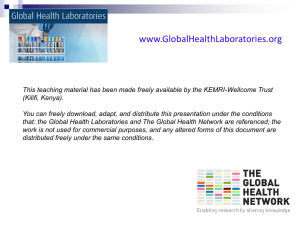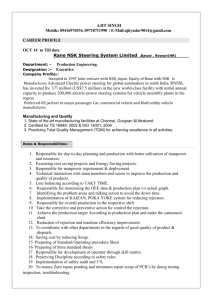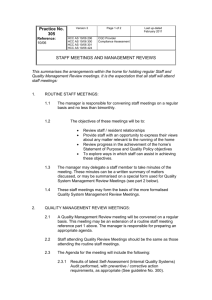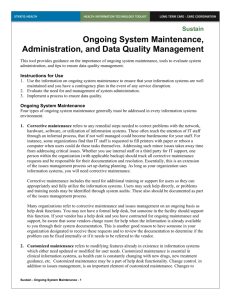File
advertisement
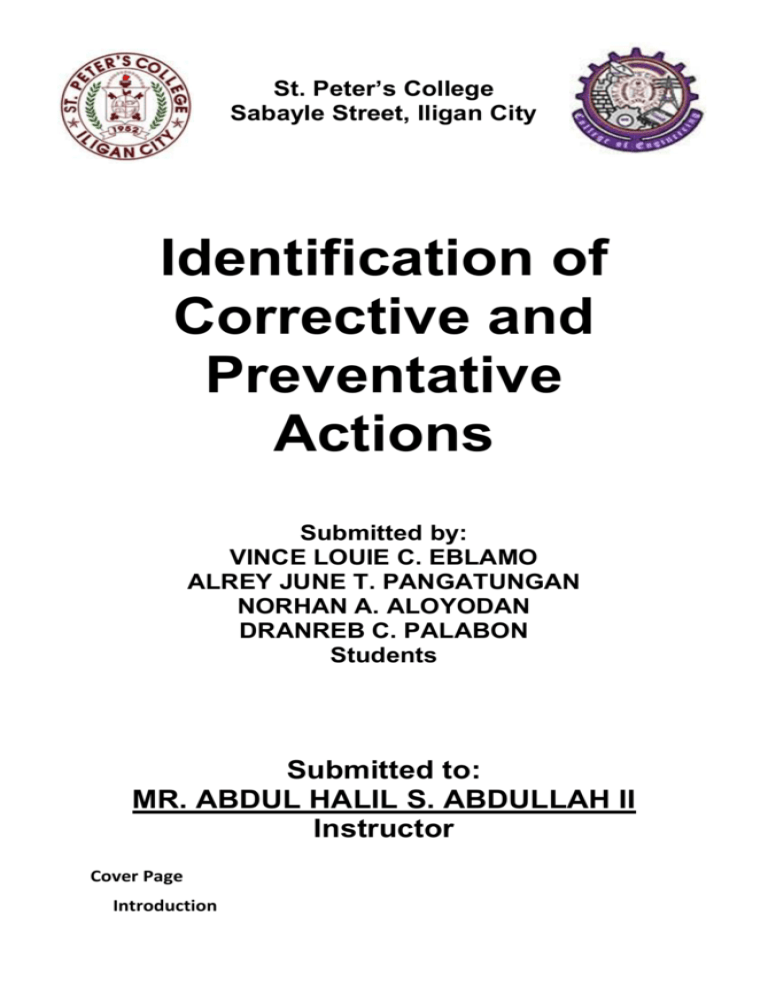
St. Peter’s College Sabayle Street, Iligan City Identification of Corrective and Preventative Actions Submitted by: VINCE LOUIE C. EBLAMO ALREY JUNE T. PANGATUNGAN NORHAN A. ALOYODAN DRANREB C. PALABON Students Submitted to: MR. ABDUL HALIL S. ABDULLAH II Instructor Cover Page Introduction Purpose/Importance CAPA Organization Concept of CAPA Examples of corrective actions Corrective and Preventive Action Processes General requirements Sources of data Corrective and Preventive Actions Procedures Problem Solving Tools Alternate Investigation flow References Introduction Corrective and Preventive Action (CAPA, also called corrective action / preventive action, or simply corrective action) are improvements to an organization's processes taken to eliminate causes of non-conformities or other undesirable situations.[1] CAPA is a concept within Good Manufacturing Practice (GMP), and numerous ISO business standards. It focuses on the systematic investigation of the root causes of identified problems or identified risks in an attempt to prevent their recurrence (for corrective action) or to prevent occurrence (for preventive action). Corrective actions are implemented in response to customer complaints, unacceptable levels of product non-conformance, issues identified during an internal audit, or adverse or unstable trends in product and process monitoring such as would be identified by Statistical Process Control (SPC). Preventive actions are implemented in response to the identification of potential sources of non-conformity. To ensure that corrective and preventive actions are effective, the systematic investigation of the root causes of failure is pivotal. CAPA is part of the overall Quality Management System (QMS). Purpose/Importance The purpose of the corrective and preventive action subsystem is to collect information, analyze information, identify and investigate product and quality problems, and take appropriate and effective corrective and/or preventive action to prevent their recurrence. Verifying or validating corrective and preventive actions, communicating corrective and preventive action activities to responsible people, providing relevant information for management review, and documenting these activities are essential in dealing effectively with product and quality problems, preventing their recurrence, and preventing or minimizing device failures. One of the most important quality system elements is the corrective and preventive action subsystem. CAPA OrganizationUnder the CAPA umbrella, the organization should include all activities and processes taken to eliminate the causes of potential nonconforming products, processes and conditions within its documented quality system. For most manufacturers of medical devices, these activities include their methods for: Complaint handing (21 CFR 820.198). Medical device reporting (21 CFR 803). Reports of corrections and removals (21 CFR 806). Product recalls (21 CFR 810). Postmarket surveillance (for companies assessed under the Medical Device Directive 93/42/EEC from the European Economic Community). Quality audits (21 CFR 820.22). Nonconforming products, processes and conditions (21 CFR 820.90 for nonconforming products). Device tracking, as appropriate (21 CFR 821). Concept of CAPA • Clearly identified sources of data which identify problems that will be investigated. • Root cause analysis to identify the cause of a discrepancy or deviation and suggest corrective actions of a problem which is identified. A common misconception is that the purpose of preventive action is to avert the occurrence of a similar potential problem. This process is all part of corrective action, because it is a process of determining such similarities that should take place in the event of a discrepancy. Preventive action is any proactive methodology used to determine potential discrepancies before they occur and to ensure that they do not happen (thereby including, for example, preventive maintenance, management review or other common forms of risk avoidance). Corrective and preventive actions both include investigation, action, review, and further action if so required. It can be seen that both fit into the PDCA (plan-do-check-act) philosophy as determined by the Deming-Shewhart cycle. Investigations to root cause may conclude that no corrective or preventive actions are required, and additionally may suggest simple corrections to a problem with no identified systemic root cause. When multiple investigations end in no corrective action, a new problem statement with expanded scope may be generated, and a more thorough investigation to root cause performed. Implementation of corrective and preventive actions is the path towards improvement and effectiveness of Quality Management Systems. Corrective actions is nothing but the action/s based on the problem identification. The problem or a non-conformance can be identified internally through staff suggestions, management reviews, document reviews or internal audits. Customer complaints / suggestions, customer rejections, non-conformities raised in customer / third party audits and recommendations by the auditors are the external sources which lead to find the root cause of the problem. Corrective action is a reaction to any of the cause/non-conformance mentioned above and can be divided in two phases of action: 1) Identification of root cause: Total Quality Management tools such as fish-bone or cause and effects analysis can be practiced. CAPA is appropriate and effective if and only if the root cause of problem(s) has been identified. 2) Taking necessary actions: The effectiveness of the corrective action taken has to be verified periodically through a systematic approach of PDCA (plan-docheck-act) cycle. Preventive action is prediction of problem and trying to avoid the occurrence (fail safe) through self initiated actions and analysis related with processes/products. This can be initiated with the help of active participation of staff members/workers through improvement teams, improvement meetings, management review, customer feedback and deciding own goals quantized in terms of business growth, reducing rejections, utilizing the equipment effectively, etc. Examples of corrective actions Error Proofing (Poka yoke) Visible or Audible Alarms Process Redesign Product Redesign Training or enhancement/ modification of existing training programmes Improvements to maintenance schedules Improvements to material handling or storage In some cases a combination of such actions may be necessary to fully correct the problem. Corrective andPreventive Action Processes Corrective Action Process Locate and document the root cause of the nonconformity. Scan the entire system to ensure no other similar nonconformity could occur. Analyze the effect such a nonconformity may have had on a product or service produced before the nonconformity was discovered, and take action appropriate to the severity of the situation by either recalling the product, notifying the customer, downgrading or scrapping product. Establish thorough follow-up to ensure the correction is effective and recurrence has been prevented. Preventive Action Process Take proactive steps to ensure a potential nonconformity does not occur. Employ process and system analysis to determine how to build in safeguards and process changes to prevent nonconformance. For example, use a failure mode and effects analysis to identify risks and potential deficiencies and to set priorities for improvement. Developmental Action Process (Treated as Preventive Actions) Initiate an improvement project, with project plans, justification for planned expenditures, resource controls and evaluation. Contain a related series of actions, often separated by long periods so you can wait and see progress and results. Use a variety of appropriate disciplines at different times during the project. Establish a means for communicating what has been done and what has to be done to facilitate communication about changes to project team members. Include a clear trail of actions taken and decisions made to substantiate the decision to proceed, document lessons learned and avoid needless reinvention on future similar projects. Documenting and controlling corrective and preventive actions ensure appropriate action is taken within a reasonable timeframe and the resulting changes work. General Requirements The CAPA system should be designed to include actions needed to correct nonconforming product and other quality problems (correction), prevent recurrence of nonconforming product and other quality problems (corrective action), and eliminate the cause of potential nonconforming product and other quality problems (preventive action). In most cases, a process approach can be followed to ensure the system captures the required information using appropriate sources of data and is effective. The concepts utilized in this approach are: The CAPA system procedures address the regulatory requirements and quality system standards. Management has provided definitions and interpretation of words or terms. Existing and potential problems are identified (quality data sources are identified and data from those sources are analyzed). Data are complete, accurate and analyzed in a timely manner. Statistical and nonstatistical techniques are used to detect recurring quality problems. Results of analyses are compared across different data sources and used to identify and develop the extent of problems. Failure investigation is adequate (procedures are followed and the investigation is commensurate with the significance and risk of the nonconformity). Where possible, the root cause has been identified. Product is controlled to prevent distribution of nonconforming product. After root causes are identified, appropriate corrective and preventive actions are taken. Actions are verified and validated, are effective and do not adversely affect the finished device. Corrective and preventive actions are documented. CAPA information is disseminated to individuals directly responsible for assuring product quality and preventing quality problems. Sources of Data Data to be included in a CAPA system come from a variety of sources, both internal and external. Some sources of internal data include: In-process and final inspection and test data. Scrap and yield data. Process control data. Incoming component testing and inspection test data. Equipment data (preventive maintenance, calibration). Internal audits. Device history records. Training records. Change control records. Rework and reprocessing. Nonconforming materials reports. Some sources of external data include: Complaints--customers, employees, MedWatch (the FDA's medical products reporting program), field service reports, journal articles, information from the FDA and other regulatory bodies. Warranty reports. Legal claims. Study reports. Third-party audits. Corrective and Preventive Actions Procedures Corrective action procedures Documentation of the identified nonconforming product, process or condition should be performed according to the organization's documented procedures. After being informed of the identified nonconformance, responsible personnel then assign appropriate personnel to investigate the nonconformance and identify its root causes. Representatives from other functions may be used. Once the investigation is completed, appropriate meetings, discussions and training sessions are held with department personnel and other groups whose activities may be impacted by the investigation and corrective action implementation. The identification of the root causes (established, in part, by failure analysis, when appropriate) is indicated on the company's appropriate documents. The documents are completed, returned to the individuals who identified the nonconformance and then reviewed according to the process described in documented procedures. Once the corrective action has been verified as implemented, the documents are forwarded to quality department personnel, who enter the corrective action information into the database for future statistical analysis. Preventive action procedures As a result of identified nonconformances (for example, identified through trending) and effective corrective actions, an individual may decide to implement a similar action to prevent the occurrence of a nonconforming condition. If department management identifies and approves a preventive action plan, it should also initiate documentation. The preventive action plan and associated documentation are described on the report form. Once the preventive action plan is accepted, the initiator verifies implementation and effectiveness. Documentation of preventive action is forwarded to quality department personnel for entry into the database and possible subsequent statistical analysis. Finally, records of corrective and preventive actions are maintained in accordance with the company's defined process for control of quality records. Alternate Investigation flow References http://asq.org/quality-progress/2005/03/problem-solving/corrective-vs-preventive-action.html http://en.wikipedia.org/wiki/Corrective_and_preventive_action http://www.fda.gov/ICECI/Inspections/InspectionGuides/ucm170612.htm http://asq.org/quality-progress/2001/11/standards-outlook/corrective-and-preventive-action-inmedical-device-manufacturing.html http://www.feinsteininstitute.org/wp-content/uploads/2013/02/PREP-29-CAPA-Template.pdf http://fmdic.org/wp-content/uploads/2012/05/Lewandowski-CAPA.pdf http://www.fda.gov/downloads/Drugs/DevelopmentApprovalProcess/Manufacturing/UCM334579.pdf http://www.rmbimedical.com/RegulatoryAffairs/capa%20guidelines.pdf

